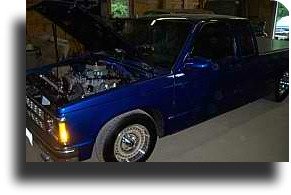Custom Paint Job
Tweet
Follow @Custom_Car_Mall
"Custom Paint Job"
How To Choose Custom Car Paint: Urethane vs. Acrylic Automotive Paint
By: lynn | Posted: Feb 15, 2012
There are many factors to consider when choosing the best Custom Paint Job for your everyday vehicle or classic car restoration project.
To most car collectors, the look and color of a car paint is the most important factor. Other things to keep in mind include cost, application difficulty level, length of drying time, possible health hazards, and base-coat and finishing options.
For simplicity's sake, I'll narrow them down to the top four most important differences: cost, difficulty level, durability and purpose.
Acrylic and urethane are two of the most common automotive paints, yet they have very important distinctions. This article will help you choose the right car paint for your car project.
Custom Paint Job
Cost is the only practical area in which acrylic enamel car paint has the clear advantage over urethane car paint, which costs more than twice as much.
Acrylic lacquer paints cost up to $250 a gallon, and acrylic enamel costs only $100-$150 per gallon for a Custom Paint Job.
Difficulty Level
Application: If properly cut and polished, the finished appearance of acrylic car paint is unbeatable. Urethane paint will give your car a "fresh look," and is easier to apply than acrylic enamel, which can only be applied with high-pressure spray guns.
Urethane car paint can be applied with low-pressure, high-volume spray guns, which are easier to control and spray larger drops for better surface coverage, but are more prone to runs. Acrylic enamel automotive paint does not completely cover the primer, thus the primer color matters more when using it.
On the other hand, urethane paint covers the primer completely, so it does not require a similarly tinted primer. Acrylic paints can be done in a home garage, and applied in a slightly cooler ambient temperature, but no colder than 18`C (65`F).
Drying Time: Acrylic car paint has a much longer drying time, 1-2 days, as opposed to the short 2-3 hours required for most urethane paints, cutting down on time between coat applications accumulation of dust.
For urethane car paint, most follow a base-coat with a clear coat. NOTE: some clear coats tint the color, especially if it is black or white. In this instance, one may prefer to use a single-stage urethane, and forgo the clear coat for the sake of the color. With urethane paint, wet-sand is also an option before applying a clear coat.
Acrylic car paints require more coats (6-8), and must always be cut and polished, after letting it harden for several weeks.
Single pack acrylic primers and fillers tend to shrink and sink back on repairs, so only use them on a final, even prime coat, and give it as long as possible to harden before wet sanding.
Both acetone, thinners and fuel spillage damage acrylic paints, and they require more maintenance to keep your car finish shiny.
In contrast, if a urethane paint job goes well, it needs no buffing, and un-buffed paint is the longest lasting and easiest to keep clean. If it is baked on, the car can be assembled the next day.
CAUTION: Urethane paints are toxic, as they contain isocyanate, airborne compounds that enter the body through the lungs and skin.
Always use safety gear (goggles, mask and gloves) and proper ventilation when working with urethane paint. Acrylic automotive paints are less toxic because they are water-based, so the resin adheres using water as its primary agent, whereas urethane depends on a solvent.
Durability
Urethane finishes are much more durable than acrylic enamel finishes. There are many factors that vary the exact length of time a finish lasts, but urethane finishes, when properly maintained, generally last 5-10 years longer than acrylic enamel finishes.
Urethane paints are activated by hardeners, so after they are mixed, they must be used promptly or the product is wasted.
Acrylic enamel paint is prone to more chipping, cracking and general wear and tear, since it does not feature the hardeners.
Purpose
Acrylic enamel car paint is typically used by professional car restorers who want to paint a classic car to exactly the original specifications, which requires acrylic enamel paint on many antique cars.
For example, acrylic enamel automotive paint is better for replicating factory orange-peel paint jobs, a bumpy surface finish.
Both auto manufacturers and car restoration professionals have now switched to urethane paint for most Custom Paint Job work, due to it's practical advantages over acrylic enamel.
It has become the standard in the auto industry because urethane car paint provides a quicker and better looking finish.
Printed From http://www.articlesbase.com/cars-articles/how-to-choose-custom-car-paint-urethane-vs-acrylic-automotive-paint-5664068.html
Return from Custom Paint Job to The Custom Car Mall Homepage.
Tell Us About your Custom Car?
Write It Here!
Do you have a great story about a custom ride, or own a custom yourself?.
Share it with us!
Tell us why you built your custom ride etc.
The Mall was built for people just like you, who would enjoy finding new products for their custom. It's a great place for showing off your ride! Show your custom project Here.
Think of This Mall as one of your local stores.







